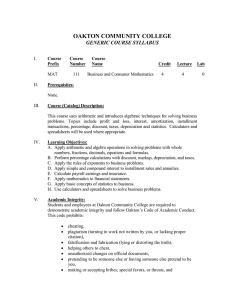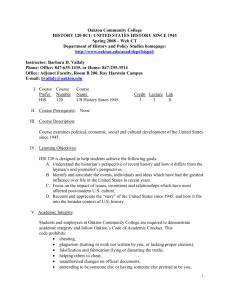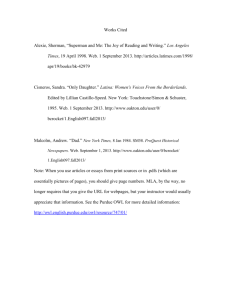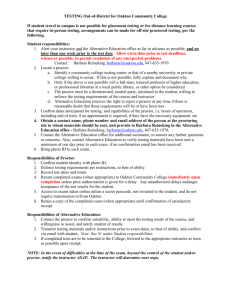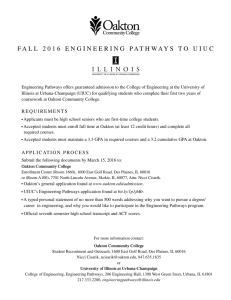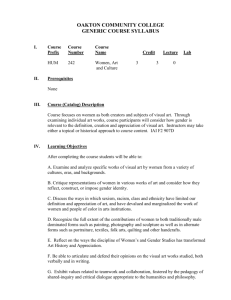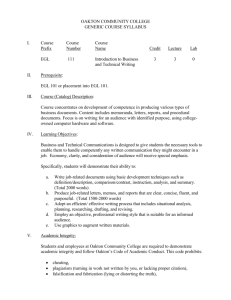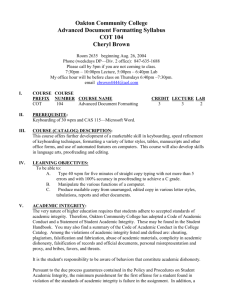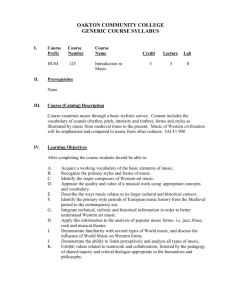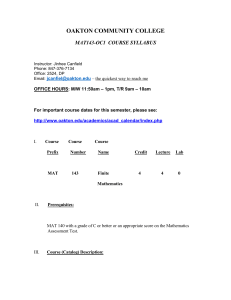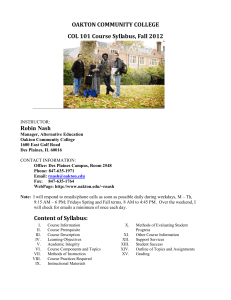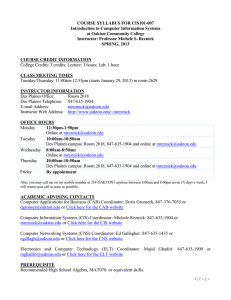Introduction to Computer Information Systems
advertisement
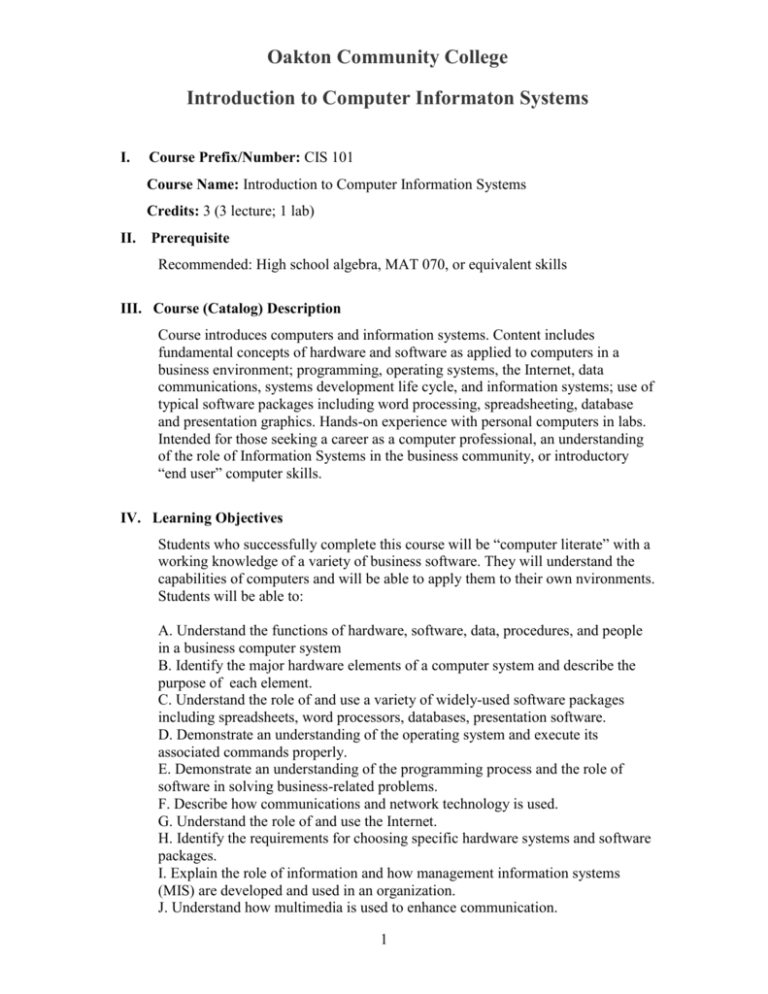
Oakton Community College Introduction to Computer Informaton Systems I. Course Prefix/Number: CIS 101 Course Name: Introduction to Computer Information Systems Credits: 3 (3 lecture; 1 lab) II. Prerequisite Recommended: High school algebra, MAT 070, or equivalent skills III. Course (Catalog) Description Course introduces computers and information systems. Content includes fundamental concepts of hardware and software as applied to computers in a business environment; programming, operating systems, the Internet, data communications, systems development life cycle, and information systems; use of typical software packages including word processing, spreadsheeting, database and presentation graphics. Hands-on experience with personal computers in labs. Intended for those seeking a career as a computer professional, an understanding of the role of Information Systems in the business community, or introductory “end user” computer skills. IV. Learning Objectives Students who successfully complete this course will be “computer literate” with a working knowledge of a variety of business software. They will understand the capabilities of computers and will be able to apply them to their own nvironments. Students will be able to: A. Understand the functions of hardware, software, data, procedures, and people in a business computer system B. Identify the major hardware elements of a computer system and describe the purpose of each element. C. Understand the role of and use a variety of widely-used software packages including spreadsheets, word processors, databases, presentation software. D. Demonstrate an understanding of the operating system and execute its associated commands properly. E. Demonstrate an understanding of the programming process and the role of software in solving business-related problems. F. Describe how communications and network technology is used. G. Understand the role of and use the Internet. H. Identify the requirements for choosing specific hardware systems and software packages. I. Explain the role of information and how management information systems (MIS) are developed and used in an organization. J. Understand how multimedia is used to enhance communication. 1 K. Understand basic systems analysis and design techniques. L. Understand computer-related ethical, security, privacy, and legal issues. M. Describe careers opportunities in the computer field. V. Academic Integrity Students and employees at Oakton Community College are required to demonstrate academic integrity and follow Oakton's Code of Academic Conduct. This code prohibits: • cheating, • plagiarism (turning in work not written by you, or lacking proper citation), • falsification and fabrication (lying or distorting the truth), • helping others to cheat, • unauthorized changes on official documents, • pretending to be someone else or having someone else pretend to be you, • making or accepting bribes, special favors, or threats, and • any other behavior that violates academic integrity. There are serious consequences to violations of the academic integrity policy. Oakton's policies and procedures provide students a fair hearing if a complaint is made against you. If you are found to have violated the policy, the minimum penalty is failure on the assignment and, a disciplinary record will be established and kept on file in the office of the Vice President for Student Affairs for a period of 3 years. Details of the Code of Academic Conduct can be found in the Student Handbook. VI. Sequence of Topics A. Introductory computer concepts 1. The major components of a computer 2. Categories of computers 3. The information processing cycle (input, process, output, and storage) 4. History of computers and related technological advances 5. Data representation and organization B. Hardware 1. Input devices 2. Output devices 3. Processing devices 4. Primary and secondary storage 5.* Use of hardware 6. Hardware selection C. Software 1. Application software 2. System software 3. Programming languages 4. Integrated software 5. Software selection D. Operating systems 1. Functions of an operating system 2. Major operating systems used today 3. Utilities and language translators 2 4. Organization, creation, access, and back-up of files and disks 5.* Operating system access and usage E. Word processing software 1. Business use of word processing 2. Word processing concepts and terminology 3.* Word processing usage F. Spreadsheet software 1. Business use of spreadsheets a. Problem solving b. Decision support 2. Concepts and terminology of spreadsheeting 3.* Spreadsheeting usage G. Database management software 1. Traditional approaches to information processing 2. File versus database systems 3. Components of a database management system 4. Database administration 5. Database organization 6.* Database usage H. Presentation software 1. Business use of presentation software 2. Concepts and terminology of presentation software 3.* Presentation software usage I. Communications, networks, and the Internet 1. Communications hardware and software 2. Data transmission 3. Types of networks 4.* Internet and the World Wide Web a. Browsers b. Finding information 5.* E-mail J. Introduction to programming 1. Overview of programming languages 2. The programming process 3. The role of structured programs 4.* Writing program code K. Introduction to systems analysis and design 1. Life cycle of a computer system 2. Role of the systems analyst 3. Analysis and design tools L. Management information systems 1. The role of information in an organization 2. How information is used in organizations 3. Types of management information systems M. Multimedia 1. Media used in multimedia applications 2. Uses of multimedia applications 3. Development of multimedia applications N. Ethical, security, privacy, and legal issues 1. Security risks and safeguards 2.* Viruses and virus protection 3 3.* Computer, disk, and file backup 4. Information privacy issues 5. Ethical issues related to the information age and the Internet 6. Copyright issues O. Career opportunities in the computer field *Laboratory instruction and hands-on exercises will be given for each of these topics. VII. Methods of Instruction Methods of instruction include lecture, class discussion, group and/or individual assignments including software applications. Course may be taught as face-toface, media-based, hybrid or online course. Course may be taught as face-to-face, media-based, hybrid or online course. VIII. Course Practices Required The student will be expected to read the text and do written and oral assignments as specified by the instructor. The student will spend one (1) hour per week (25% of the course) in scheduled lab activities using word processing, spreadsheet and database software. In addition 15 - 25% of lecture time will be spent on discussing the use of business software tools. IX. Instructional Materials Note: Current textbook information for each course and section is available on Oakton's Schedule of Classes. X. Methods of Evaluating Student Progress A. Quizzes to be determined by instructor B. Exams (essay, multiple choice, fill-in-the-blank) to be determined by instructor C. Evaluation of lab exercises D. Evaluation of other homework assignments (e.g. student presentations, research papers) XI. Other Course Information Application software used: Office 2010 (Word, Access, Excel, PowerPoint), Windows 7 or higher, Internet Brower, email, programming language (e.g., Visual BASIC) If you have a documented learning, psychological, or physical disability you may be entitled to reasonable academic accommodations or services. To request accommodations or services, contact the Access and Disability Resource Center at the Des Plaines or Skokie campus. All students are expected to fulfill essential course requirements. The College will not waive any essential skill or requirement of a course or degree program. 4 XII. Instructor: Dave Geller Chair, Manufacturing and CAD Technology 847-376-7707 dgeller@oakton.edu This workforce solution was funded by a grant awarded by the U.S. Department of Labor’s Employment and Training Administration. The solution was created by the grantee and does not necessarily reflect the official position of the U.S. Department of Labor. The Department of Labor makes no guarantees, warranties, or assurances of any kind, express or implied, with respect to such information, including any information on linked sites and including, but not limited to, accuracy of the information or its completeness, timelines, usefulness, adequacy, continued availability, or ownership. This solution is copyrighted by the institution that created it. Internal use, by an organization and/or personal use by an individual for non-commercial purposes, is permissible. All other uses require the prior authorization of the copyright holder. 5
